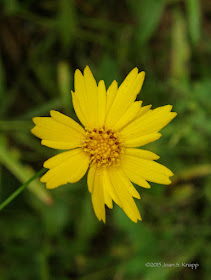August 21st. When I visited Fort Yargo State Park in mid-February,
there were few signs of Spring. The only wildflower plants that were obvious
were the leaves of Cranefly Orchids (Tipularia
discolor) that I found in many places.
The route… I’ve described it here, here, here, and here. This walk doesn’t have the variety of wildflowers as my other
walk from the Group A Shelter to the Old Fort but it does have some gems. One
of the Smallflower (Asimina parviflora)
had developed fruit that, unfortunately, it had lost; the Pink Lady’s Slipper (Cypripedium acaule) Orchids had bloomed,
and some Green Adder’s-mouth (Malaxis
unifolia) Orchids had bloomed and two were setting seeds. For the moment,
some wildflowers we still blooming but there was a lull between seasons. I had thought
that the slime mold fruiting was done for the year, but I was in for a
surprise.
Near the beginning of the trail, the smaller Trumpetweed/Joe
Pye Weed (Eutrochium fistulatum)
plants were still blooming.
In the main woods, St. Andrews Cross (Hypericum hypericioides) plants were still blooming.
Kudzu (Pueraria montana) vines were also still blooming in the main woods.
I was surprised to find Coral Slime (Ceratiomyxa fruticulosa var. fruticulsa) fruiting in a location I
had never seen it before.
the slime mold fruiting bodies. These were a little atypical
in not forming the typical ‘rosettes’ that I was used to seeing.
The Witch’s Butter (Tremella
mesenterica), that rehydrated after more rain, was pale in contrast to the
rich yellow color I had seen previously.
The Bicolor Lespedeza (Lespedeza
bicolor) was still blooming; this is one of the longest blooming plants in
these woods.
I’m always surprised to find Atlantic Pigeonwings (Clitoria mariana) blooming along this
trail. A small plant had a single flower.
On the first log I check, I found…
Coral Slime fruiting bodies that had formed the typical
‘rosette’ formations.
In addition, I found another atypical presentation of the
Coral Slime fruiting bodies; these were ‘stubby’ compared with the typical tubes
and had ‘knobby’ tips. Colleagues on the Facebook Slime Mold Identification and Appreciation group confirm that these are the Coral Slime in an atypical
presentation.
In addition, there were some immature (pink) Wolf’s Milk (Lycogala epidendrum) fruiting bodies.
Some mold was developing on the fruit on the Tulip Poplar (Liriodendron tulipifera) tree.
One of the densest area of Hairy Elephantfoot (Elephantopus tomentosus) was located
just across the trail from the Tulip Poplar.
At the end of the dam, the Lanceleaf Coreopsis (Coreopsis lanceolata) had some fresh
blooms.
At the beginning of the return trail, the Hairy Angelica (Angelica venenosa) seeds were still
developing nicely.
Just across the trail from some of these mushrooms I found a
rare sight for this time of year; a lichen (that I haven’t been able to
identify) with fruiting bodies.
I found yet another Orange Sponge Polypore (Pycnoporellus alboluteus) fruiting body
on a rotten pine log on the north-facing trail section. I had now found this
fungus at three locations in the park.
I found this pretty mushroom, a Pholiota sp., fruiting on a fallen log, also on the north-facing section of trail.
A little further along the trail, I was in for a couple of
pleasant surprises.
(To be continued…)
Related posts:
- Summer On A Fort Yargo State Park Trail: Section
B To The Dam, July 29th (Part 1)
- Spring Is In The
Air: Fort Yargo State Park, Section B To The Dam, May 1st (Part 2)


























No comments:
Post a Comment